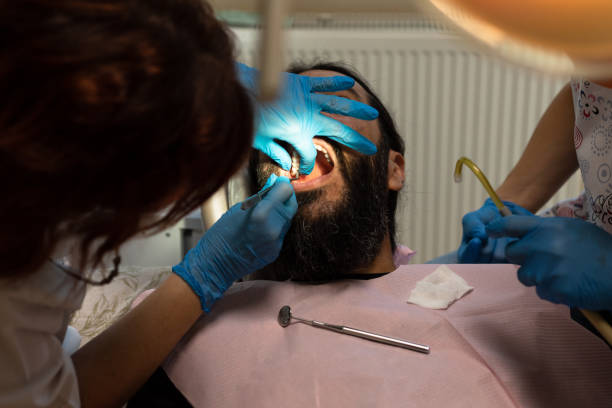Does dental insurance cover implants? In the realm of modern dentistry, dental implants have emerged as a groundbreaking solution for individuals seeking permanent replacements for missing teeth.
These titanium wonders mimic the natural tooth structure, offering both aesthetic appeal and functional benefits.
However, as with many advanced dental procedures, the question of financial coverage arises. “Does dental insurance cover implants?” is a query that often perplexes those considering this transformative dental option.
While the answer isn’t a simple yes or no, understanding the complexities of dental insurance coverage for implants is crucial for making informed decisions about your oral health and financial well-being.
In this article, we will delve into the intricacies of dental insurance and its relationship with implant coverage, shedding light on the factors that influence reimbursement, limitations to be aware of, and alternative pathways for those seeking to restore their smiles with dental implants.
Also Read:
Does Insurance Cover Invisalign?
Is Dental Insurance Worth It? (Find Out Now)
Does Dental Insurance Cover Implants?
The question of whether dental insurance covers implants hinges on various factors within policy frameworks.
Generally, many traditional dental insurance plans tend to exclude or offer limited coverage for dental implants, categorizing them as elective or cosmetic procedures.
Implants are often viewed as premium treatments, which might place them outside the scope of basic coverage.
Coverage can vary widely depending on the insurance provider, plan type, and specific policy terms.
Some insurance plans might offer partial coverage for implant-related procedures, such as diagnostic exams or dental crowns that are part of the implant process.
However, the implant surgery itself and related costs may frequently be considered out-of-pocket expenses.
Increasing demand and recognition of the significance of implants have led to a shift in some insurance policies.
Specialized dental insurance plans or enhanced coverage options may now exist to accommodate implants, albeit with potentially higher premiums.
Another avenue is discount plans, which offer reduced rates for various dental treatments, including implants, though they are not insurance in the traditional sense.
Overall, dental insurance coverage for implants is a nuanced landscape.
Prospective patients should meticulously review policy details, inquire about coverage specifics, and explore alternative financing options to make informed choices regarding implant procedures and associated expenses.
Limitations and Exclusions of Dental Insurance
Dental insurance, while providing valuable financial support for oral healthcare, often comes with limitations and exclusions that can impact coverage effectiveness.
These restrictions are integral components of insurance policies and are important for policyholders to understand.
Common limitations include waiting periods before certain services are covered, meaning policyholders must wait for a specified time before utilizing coverage.
Pre-existing conditions might also be excluded from coverage, especially in the initial policy period.
Additionally, there are annual maximums that cap the amount an insurer will pay within a year, potentially leaving patients responsible for costs exceeding the limit.
Exclusions pertain to services not covered by the insurance plan.
Cosmetic procedures, like teeth whitening, are often excluded, as are orthodontic treatments for adults.
Dental insurance may also not cover certain treatments deemed experimental or elective, like some specialized treatments or implants.
Maintenance procedures like teeth cleanings might have frequency limits.
Understanding these limitations and exclusions is crucial to managing expectations and making informed decisions about oral healthcare.
Policyholders should carefully review policy documents, consult with insurance providers, and consider supplementary plans or alternative financing options to address potential gaps in coverage and ensure comprehensive dental care.
Alternative Options for Implant Coverage
For individuals seeking implant coverage beyond traditional dental insurance, alternative options can provide avenues to manage the costs associated with this transformative dental procedure.
- Discount Dental Plans: These plans offer reduced rates for various dental treatments, including implants. Although they are not insurance, they can significantly lower the out-of-pocket expenses for implants and related procedures.
- Health Savings Accounts (HSAs) and Flexible Spending Accounts (FSAs): These tax-advantaged accounts allow individuals to set aside pre-tax funds for medical expenses, including dental treatments. Implants may qualify, enabling individuals to use these funds to cover a portion of the costs.
- Supplemental Dental Insurance: Some insurers offer supplemental plans specifically designed to cover procedures like implants. While these plans might have higher premiums, they can provide more comprehensive coverage for specific treatments.
- Medical Tourism: Exploring implant options in countries with lower healthcare costs might be an option for cost-conscious individuals. However, thorough research and consideration of travel expenses and quality of care are crucial.
- Financing and Payment Plans: Many dental offices offer financing options, allowing patients to spread out the implant costs over time. This can make the procedure more affordable by breaking down the expense into manageable installments.
- Employer-Sponsored Benefits: Some employers offer dental benefits that cover implants or include supplementary plans that can be added to existing insurance.
Considering these alternative options can help individuals navigate the financial aspects of dental implant procedures and ensure that they receive the care they need while minimizing the burden on their wallets.
Also Read:
How Can Mortgage Fraud Be Detected?
How Does a Reverse Mortgage Work in California?
Conclusion
When it comes to dental care, the coverage of implants by insurance remains a nuanced landscape.
While traditional plans often offer limited or no coverage due to categorization as elective procedures, evolving perspectives, and specialized plans are beginning to address this gap.
Thoroughly understanding policy details, including limitations and exclusions, is essential.
Patients can explore alternative avenues such as discount plans, savings accounts, supplemental insurance, and financing options to bridge financial gaps.
Ultimately, informed decision-making is key to ensuring access to the transformative benefits of dental implants while effectively managing costs.






